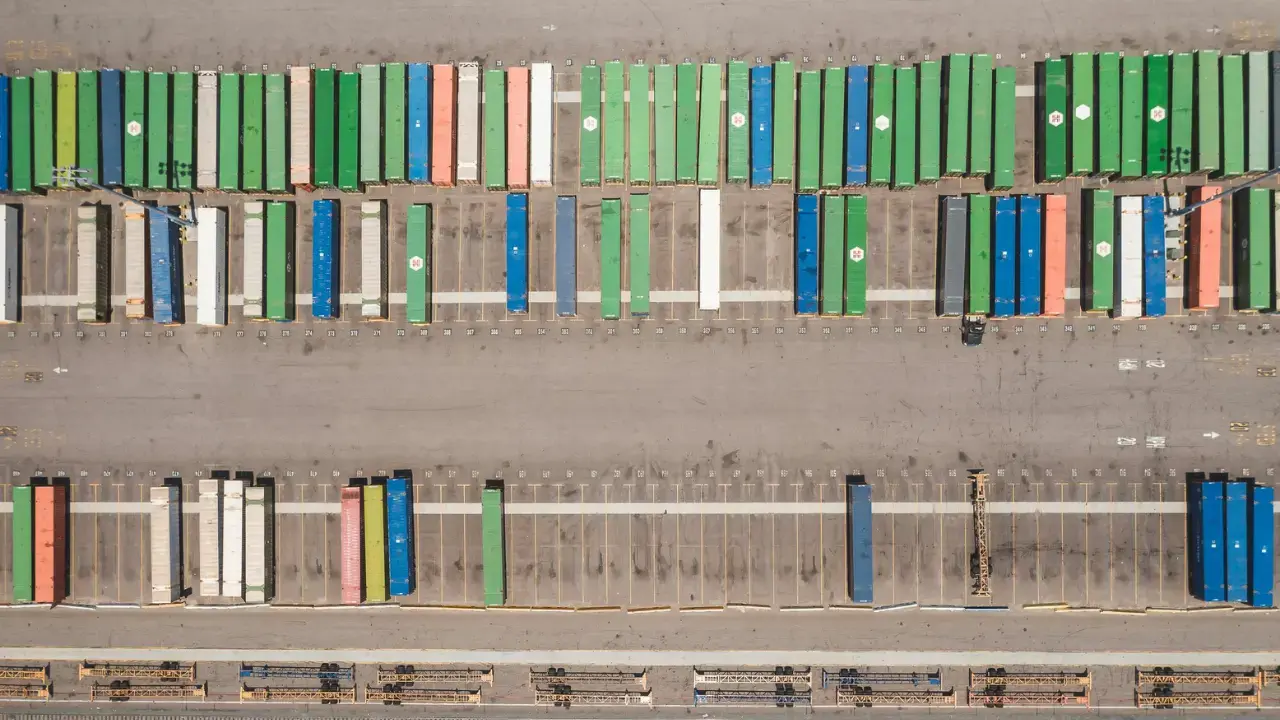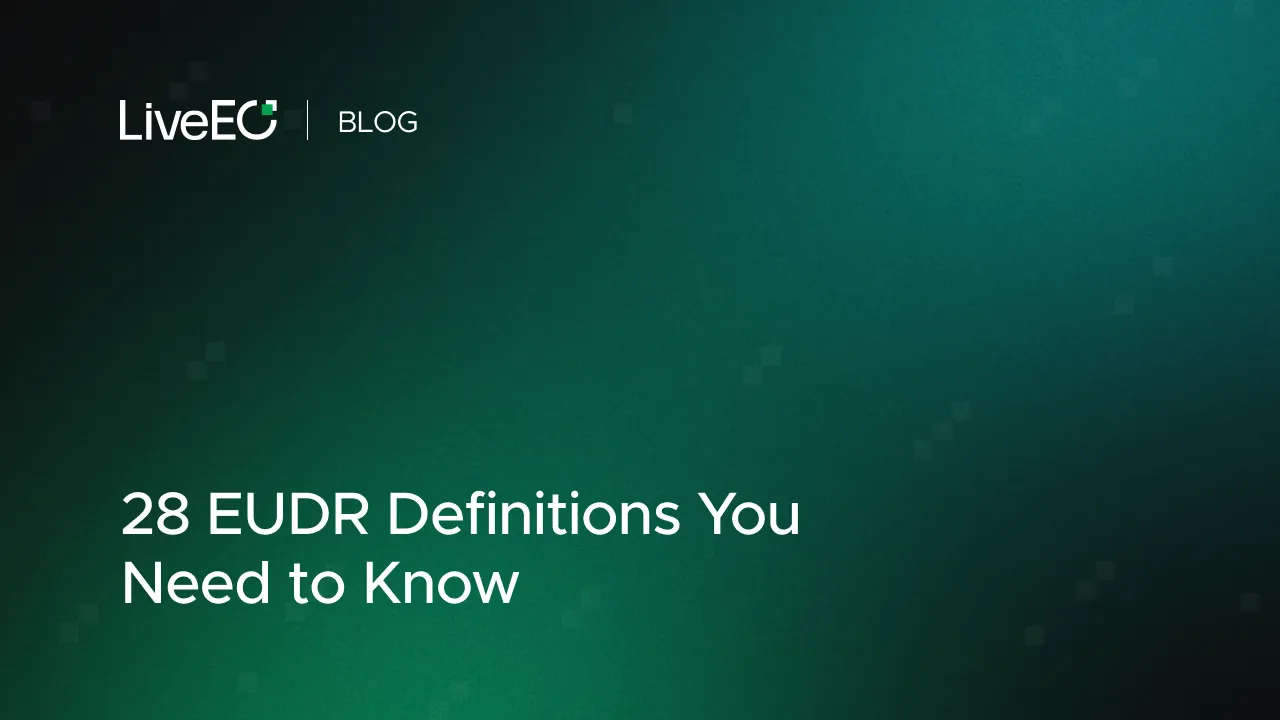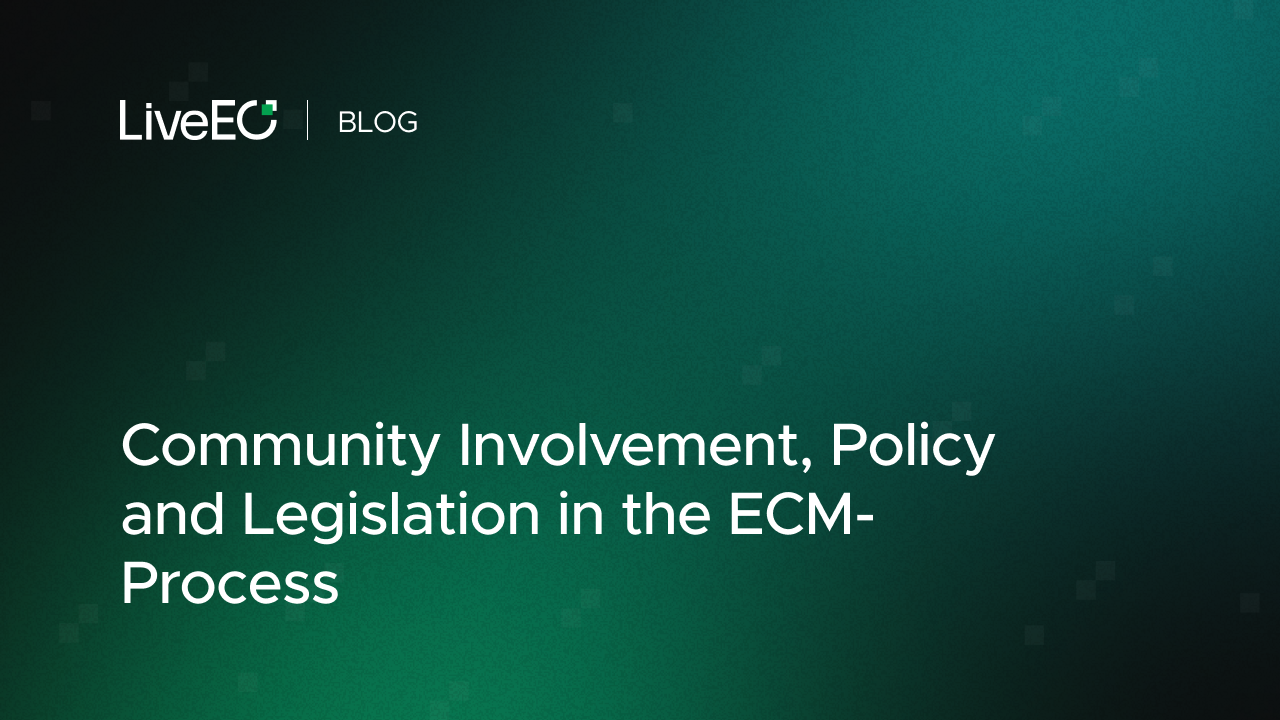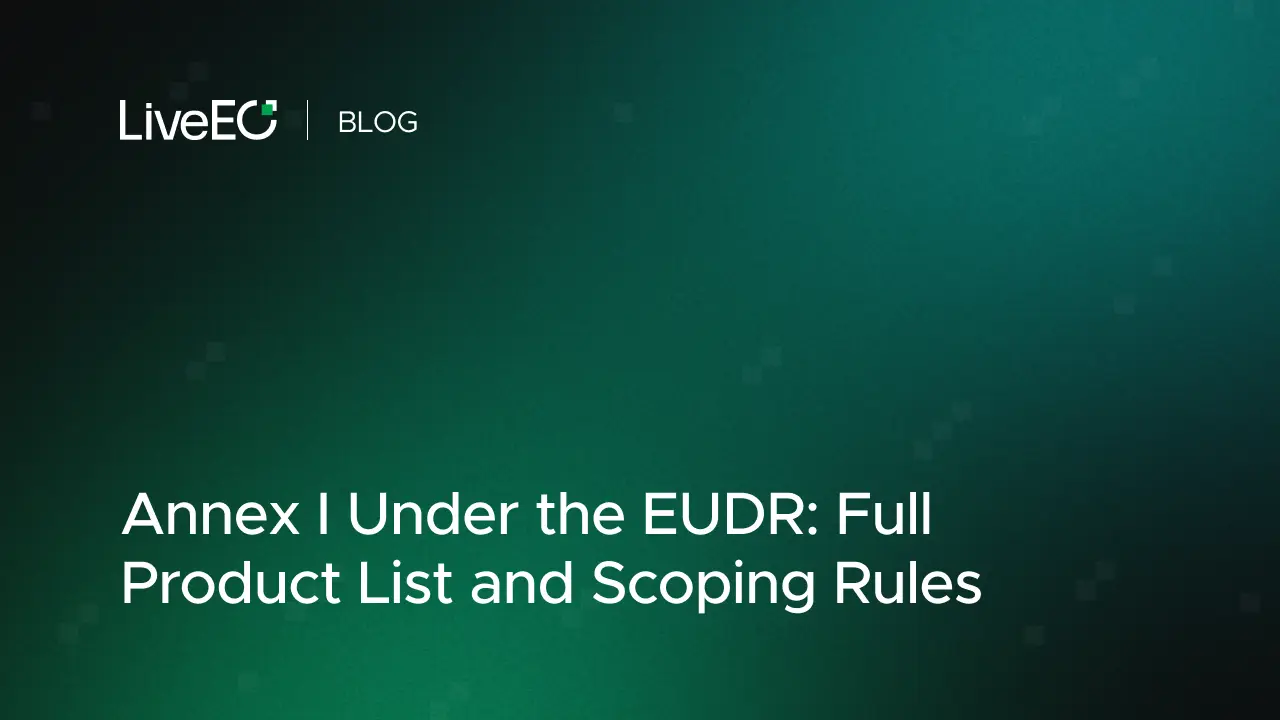
The EU Deforestation Regulation (EUDR), set to come into force at the end of 2025, is poised to reshape global trade and supply chain practices.
Focused on mitigating deforestation and forest degradation, the regulation demands businesses importing or exporting certain high-risk commodities to ensure they are sourced sustainably.
This shift comes with a steep learning curve, particularly when it comes to understanding key EUDR terminology.
In this article, we’ll explore the 28 most essential EUDR definitions to help you navigate the regulatory requirements effectively.
Whether you’re responsible for supply chain management, due diligence, or risk assessment, knowing these terms is the first step towards full compliance and maintaining your access to the EU market.
Key Takeaways
- A clear understanding of essential EUDR definitions like relevant commodities, geolocation, and due diligence is crucial for businesses to comply with the regulation.
- The European Union Deforestation Regulation (EUDR) applies to high-risk commodities such as soy, palm oil, coffee, cocoa, and timber, which must be sourced from deforestation-free land.
- Companies are required to implement a due diligence system that includes collecting geolocation data, conducting risk assessments, and documenting sustainability efforts to meet EUDR standards.
- Ensuring transparency and traceability throughout the supply chain is essential to proving compliance with EUDR regulations, requiring accurate documentation of commodity origins.
- Non-compliance with EUDR can lead to penalties, including market exclusion and fines of up to 4% of EU-based revenue.
- Specifically designed to align with EUDR definitions, TradeAware helps businesses adhere to EUDR. Try TradeAware Lite, the free version of the solution, and start working towards your compliance today.
What is EUDR and Why Is it Important
The European Union Deforestation Regulation (EUDR) is a landmark policy aimed at preventing the trade of commodities linked to deforestation and forest degradation.
Expected to take full effect at the end of 2025, the EUDR applies to products like soy, palm oil, coffee, cocoa, and timber, which are often linked to deforestation practices.
The regulation requires businesses importing or exporting these commodities into the EU to ensure that they come from deforestation-free sources, with a cutoff date of December 31, 2020, for forest clearance.
At its core, EUDR demands rigorous due diligence from operators and traders, including geolocation data of production areas, detailed risk assessments, and regular reporting obligations.
The goal is to not only safeguard forests but also to help the EU meet its environmental goals related to biodiversity conservation and climate change mitigation.
The European Union Deforestation Regulation’s Impact on Supply Chains
The EUDR introduces significant changes to how supply chains operate, especially for businesses involved in high-risk commodities.
The regulation imposes stricter transparency and traceability requirements, meaning companies must now map out and document the exact origin of their goods.
- Increased Compliance Costs: Businesses will need to invest in technology and tools, such as satellite monitoring and geolocation systems, to trace the origins of their raw materials. Solutions like LiveEO’s TradeAware platform can help streamline these processes by offering advanced geospatial data analytics and risk assessment tools.
- Risk of Supplier Exclusion: Suppliers who cannot verify the deforestation-free status of their commodities risk being cut off from the EU market. This could force companies to either replace non-compliant suppliers or invest in sustainable practices at the source.
- Market Access Challenges: For companies that rely heavily on exporting to the EU, non-compliance with EUDR could result in severe penalties, including exclusion from the EU market, which could disrupt revenue streams and operations.
In short, EUDR is reshaping global supply chains by prioritizing environmental responsibility and enforcing stricter transparency measures.
The EUDR Definitions You Need To Understand to Comply
Understanding the key terms outlined in the European Union Deforestation Regulation (EUDR) is the foundational step in preparing your business to adhere to the new regulations.
The EUDR definitions shape how you should approach due diligence, supply chain traceability, and risk management to ensure full compliance.
Definition 1: Relevant commodities
As defined in Article 2(1) of the EUDR, relevant commodities refer to specific high-risk goods linked to deforestation.
These commodities include cattle, cocoa, coffee, oil palm, rubber, soy, and timber.
Each of these commodities has been identified for its potential contribution to deforestation through their cultivation or production processes.
Definition 2: Relevant Products
According to Article 2(2) of the EUDR, relevant products are those that contain, have been fed with, or have been made using relevant commodities.
The regulation lists these products in Annex I, which includes not only raw materials but also goods that involve relevant commodities during production, such as foods, furniture, and paper products.
Definition 3: Deforestation
The EUDR’s objective is to ensure that no relevant commodities entering the EU market are sourced from land deforested after December 31, 2020.
As per Article 2(3), deforestation is defined as the conversion of forest to agricultural use, whether human-induced or not.
This includes clearing forests for farming, plantations, or livestock rearing. Natural forest conversions—such as those caused by wildfires, volcanic eruptions, storms, or floods—can lead to significant tree loss. Even though these events are natural, if the affected areas are subsequently converted to agricultural use, they would still be classified as deforested under the EUDR.
Read also: What is Forest Degradation? Definition, Causes, and Mitigation Under EUDR
Definition 4: Forest
As defined in Article 2(4) of the EUDR, a forest is land spanning more than 0.5 hectares with trees higher than 5 meters and a canopy cover of more than 10%, or land where trees can reach these thresholds in situ.
Importantly, this definition excludes land predominantly used for agriculture or urban development.
The regulation focuses on these characteristics to ensure that forests remain intact and are not misclassified due to partial human activities. Food and Agriculture Organization (FAO) definitions are used to establish regulatory frameworks for forests, illustrating the organization's role in defining and classifying vital ecosystems.
Read also: How to Comply with EUDR Requirements Using Your Existing Supply Chain Systems
Definition 5: Agricultural Use
According to Article 2(5), agricultural use refers to the use of land for agriculture, including the cultivation of crops, rearing livestock, and the establishment of agricultural plantations or set-aside agricultural areas. The definition encompasses a broad range of agricultural activities, recognizing that many forms of land use intersect with forestry and environmental sustainability.
Definition 6: Agricultural Plantation
As outlined in Article 2(6), an agricultural plantation is land where tree stands are part of an agricultural production system, such as fruit tree plantations, oil palm plantations, and agroforestry systems where crops are grown under tree cover. This definition applies to all plantations producing relevant commodities, excluding wood plantations, which are regulated under different provisions.
Definition summary:
- Agricultural plantations are defined as tree-covered land used for the cultivation of crops like fruits or oil palm.
- These plantations are not classified as forests and are subject to different rules under the EUDR.
- Protecting natural forests from conversion into agricultural plantations is a key objective of the EUDR to prevent deforestation.
Definition 7: Forest Degradation
According to Article 2(7) of the EUDR, forest degradation refers to structural changes in forest cover that lead to the conversion of primary or naturally regenerating forests into plantation forests or other types of wooded land, or the transformation of primary forests into planted forests. This degradation reduces the ecological value of forests, impacting biodiversity and their ability to provide ecosystem services.
Definition 8: Primary Forest
As described in Article 2(8), a primary forest is a naturally regenerated forest composed of native tree species, where there are no visible signs of human activities, and the ecological processes have not been significantly disturbed. Primary forests are considered unique and irreplaceable due to their biodiversity and the complexity of their ecosystems.
Check out also: Leveraging Satellite Technology for Sustainable Supply Chains
Definition 9: Naturally Regenerating Forest
As defined in Article 2(9), naturally regenerating forest consists predominantly of trees established through natural regeneration. This can include a mix of naturally regenerated trees and planted trees, but the naturally regenerated trees are expected to constitute the major part of the growing stock at stand maturity.
Definition 10: Planted Forest
As defined in Article 2(10) of the EUDR, a planted forest consists predominantly of trees established through planting or deliberate seeding.
These trees are expected to constitute more than 50% of the growing stock at stand maturity.
Planted forests may include coppice from trees originally planted or seeded. This type of forest is distinct from naturally regenerating forests, as it relies on human intervention for establishment and growth.
Read also: The Road to EUDR: Key Dates and Milestones in the EU's Deforestation Regulation
Definition 11: Plantation Forest
Under Article 2(11), a plantation forest refers to an intensively managed planted forest that meets specific criteria at both planting and stand maturity.
These forests typically consist of one or two tree species, are even-aged, and are planted with regular spacing. Plantation forests include short-rotation plantations for wood, fiber, and energy.
However, they do not include forests established for protection, ecosystem restoration, or those planted to resemble naturally regenerating forests at maturity.
Definition 12: Deforestation-Free
As defined in Article 2(13) of the EUDR, deforestation-free means that relevant commodities or products were produced on land that has not been subject to deforestation after December 31, 2020.
{{inline}}
For products containing or made using wood, the wood must be harvested without inducing forest degradation after the same date. This cutoff is designed to prevent products linked to recent deforestation from entering the EU market.
Definition 13: Operator
As defined in Article 2(15) of the EUDR,an operator is any natural or legal person who, in the course of a commercial activity, places relevant products on the EU market or exports them.
This includes businesses responsible for ensuring that the products comply with the regulation’s deforestation-free and due diligence requirements before they are sold or exported.
The operator must collect data, perform risk assessments, and provide a due diligence statement as part of their obligations under the regulation. Moreover, the operator must publicly report on their diligence system annually as part of their compliance obligations.
Read also: Achieving EUDR Compliance: A Guide to Deforestation Data Sources
Definition 14: Trader
Under Article 2(17), a trader is any person in the supply chain other than the operator who makes relevant products available on the market during the course of a commercial activity. While traders are not responsible for the initial due diligence required by operators, they must maintain documentation and be able to trace the products back to compliant sources. Traders must also ensure that the products they handle meet EUDR standards and are deforestation-free.
Definition 15: Authorised Representative
According to Article 2(22), an authorised representative is any natural or legal person established in the EU who has received a written mandate from an operator or trader to act on their behalf concerning specified tasks under the EUDR. While the authorised representative can submit due diligence statements on behalf of an operator or trader, the original entity remains responsible for the compliance of the product with EUDR standards.
Definition 16: Country of Origin
As defined in Article 2(23) of the EUDR, country of origin refers to the country or territory as mentioned in Article 60 of Regulation (EU) No 952/2013, which determines the economic nationality of the product based on the origin of its components and production processes. The "country of origin" helps identify where a product was manufactured or processed for the purposes of customs, trade, and regulation.
Definition 17: Country of Production
Article 2(24) of the EUDR defines country of production as the country or territory where the relevant commodity or the raw materials used in the production of a relevant product were grown, harvested, or produced. For example, this could refer to the nation where soybeans used in a product were cultivated. This term is crucial in tracking the compliance of commodities with deforestation-free requirements.
Definition 18: Non-Compliant Products
According to Article 2(25), non-compliant products are relevant products that do not meet the standards established in Article 3 of the EUDR. This includes products that are not deforestation-free or have been produced in violation of the relevant legislation of the country of production. Such products are not permitted for sale or export within the EU market and may be subject to penalties or corrective actions.
Definition 19: Negligible Risk
As defined in Article 2(26) of the EUDR, negligible risk refers to the level of risk applied to relevant commodities and products where, after a full assessment of both product-specific and general information, including any necessary mitigation measures, there is no cause for concern that the product is not in compliance with Article 3 of the EUDR. Essentially, if the risk of deforestation or forest degradation is deemed negligible, the product may be placed on the EU market.
Definition 20: Plot of Land
In Article 2(27), a plot of land is defined as a specific area of land within a single real-estate property, as recognized by the law of the country of production. The conditions on this plot must be homogeneous enough to allow an assessment of the risk of deforestation and forest degradation for commodities produced on that land. This definition is key to traceability, as geolocation data for each plot must be provided for products that contain or are made from relevant commodities.
Definition 21: Geolocation
According to Article 2(28) of the EUDR, geolocation refers to the geographic location of a plot of land, expressed through latitude and longitude coordinates.
For plots larger than four hectares used for relevant commodities (other than cattle), geolocation must be provided using polygons to outline the entire perimeter of the land.
This requirement ensures accurate traceability of where commodities are grown or harvested, a critical part of verifying compliance with the EUDR.
Check out also: Geolocation Gathering Webinar with PEFC: Q&A Summary
Definition 22: Competent Authorities
As defined in Article 2(32), competent authorities are those designated by Member States to fulfill the obligations under the EUDR. These authorities are responsible for enforcing the regulation, conducting checks on operators and traders, and ensuring that products placed on the market comply with the EUDR's deforestation-free requirements. Competent authorities must have sufficient powers, resources, and independence to carry out their duties effectively.
Read also: EUDR Competent Authorities - Updated List
Definition 23: Due Diligence
As defined in Article 8 of the EUDR, due diligence refers to the procedures that operators must follow before placing relevant products on the EU market or exporting them.
This involves collecting information, conducting risk assessments, and applying mitigation measures to ensure compliance with the EUDR’s deforestation-free requirements. Involving relevant stakeholders is crucial to ensure that due diligence processes are effective and take into account various interests, especially concerning legal compliance and tailored support for specific sectors.
Due diligence must be documented and retained for at least five years, and operators are responsible for maintaining compliance throughout the entire process.
Definition 24: Due Diligence Statement
According to Article 4(2), a due diligence statement is a formal declaration by operators, confirming that they have conducted due diligence in line with the EUDR.
This statement must be submitted to competent authorities before relevant products are placed on the market or exported. It includes information such as geolocation of production plots and the results of risk assessments.
The due diligence statement is a key compliance document for ensuring deforestation-free products.
Read also: The Long-Term Impact of EUDR on Global Trade and Conservation Efforts
Definition 25: EU Market
As defined in Article 2(16), the EU market refers to the collective economic space within the European Union where goods are bought, sold, and traded. The EUDR applies to products made available on this market, requiring that they meet deforestation-free criteria before being sold or distributed. Only products that comply with the EUDR's standards can be placed on the EU market.
Definition 26: Natural Person
As described in Article 2(20), a natural person refers to an individual who, in a personal capacity, is involved in the trade or placing of relevant products on the market. This contrasts with legal entities, which are businesses or organizations. Under the EUDR, natural persons, like operators or traders, must also ensure that products comply with deforestation-free requirements.
Definition 27: Risk Assessment
Under Article 10 of the EUDR, risk assessment is a process that operators must follow to determine whether the relevant products pose any risk of non-compliance with deforestation-free requirements. Operators must evaluate information about the product's origin, including geolocation data and the risk of deforestation or forest degradation. Only products assessed as having no more than negligible risk may be placed on the EU market.
Definition 28: Supply Chain Traceability
According to Article 9, supply chain traceability involves tracking the movement of relevant products from their origin to their placement on the EU market. Under the EUDR, businesses must ensure transparency throughout the supply chain, including collecting data on where commodities are produced and how they move through the supply chain. This ensures that products can be verified as deforestation-free.
Compliance EUDR: Steps To Take
Complying with the European Union Deforestation Regulation (EUDR) is essential for businesses that trade in commodities such as soy, palm oil, coffee, and timber.
As the regulation becomes enforceable at the end of 2025, companies must take proactive steps to ensure that their supply chains are transparent and that products meet the stringent deforestation-free requirements.
To ensure compliance with the EUDR, businesses must implement robust due diligence systems that focus on transparency, traceability, and risk management.
Here are the key steps to follow:
- Conduct Risk Assessments
Businesses need to thoroughly assess the risk of deforestation in their supply chains by evaluating where and how their commodities are sourced. - Collect Geolocation Data
A key component of compliance is providing precise geolocation data for every plot of land where commodities are produced. This data must show that the land has not been subject to deforestation or degradation after December 2020. - Ensure Supply Chain Traceability
Traceability is critical to proving compliance with EUDR standards. Businesses must maintain accurate documentation of their entire supply chain to demonstrate that commodities are deforestation-free. - Engage with Suppliers
It’s important to work closely with suppliers to gather necessary compliance data and ensure they are following sustainable practices. Regular communication and collaboration will ensure smoother compliance.
- Prepare a Due Diligence Statement
Companies are required to prepare and submit a due diligence statement for each product, which includes details on risk assessments, geolocation information, and mitigation measures taken to avoid deforestation-related risks.
The Risks of Not Complying with EUDR
Failing to comply with the EUDR can have significant financial, operational, and reputational consequences.
The EU has put in place strict penalties for businesses that do not adhere to the regulation, including market exclusions and heavy fines.
Operators that are found in breach of EUDR regulations can face fines of up to 4% of their EU-based revenue.
For a more detailed breakdown of the consequences of non-compliance, including potential penalties and the risk of losing market access, read this article on EUDR non-compliance penalties.
Conclusions
The European Union Deforestation Regulation is set to transform the way businesses manage their supply chains by enforcing strict sustainability and deforestation-free standards.
As companies navigate this new regulatory landscape, a clear understanding of the key definitions is crucial. From "due diligence" to "geolocation," these terms define how businesses must operate to ensure full compliance and mitigate risks.









